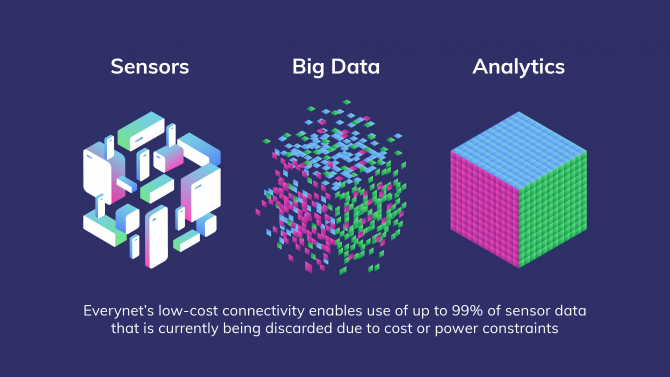
Sensor data acquisition for machine learning and digitization projects
By Vitaliy Kleban, chief technology officer, Everynet
Electronics Interconnect Test & Measurement Wireless IoT connectivity data data acquisition digitization IoT LoRaWAN machine learning sensorsLow-cost connectivity enables use of up to 99% of sensor data that is currently being discarded due to cost or power constraints
The digital transformation market is growing rapidly and is set to reach a volume of one trillion dollars by 2025. Machine learning is also quickly gaining traction and is projected to grow to volumes amounting to trillions of dollars over the next couple of decades. Such market dynamics are resulting in an immense demand for appropriate solutions, and the development of a supply to match.
But the insufficiency of data is one of the main reasons why both machine learning and digitization projects fail. Data starvation puts multimillion dollar investments into digitization projects at risk. The availability of data is often being overestimated, leading to breakdowns in planned processes that were built on estimations and predictions, rather than preliminary analysis during project development. Such a state of affairs is considered unacceptable by both investors and the market that requires wholesome datasets to support operations.

Source: Everynet
Hardware is taking up a bigger role in software-related processes, as machine learning algorithms and digital transformation software need smart sensors to gain access to the real world. The availability of this vital link, and the overseers ensuring the authenticity of the data, is the key to providing constant data streams for improving machine learning efficiency.
The main challenge for data collection arises from the fact that computational efficiency has improved exponentially over the past decades, whereas wireless transmission continues to be energy-intensive and expensive. Historically, wireless communications are moving towards higher bandwidths for obvious reasons. Currently, 4G features an amazing 300 megabit per second download speed, which is already high enough to provide the necessary volumes of data transmission needed for next-gen AI systems to operate.
High throughput devices are not cheap
But not all devices require such an enormous amount of throughput. Billions of devices, such as water and energy meters, pallet and roll cage trackers, predictive maintenance sensors, and many other less complicated types of hardware, only need to report a very small amount of data several times a day. This makes the use of 4G and higher bandwidths an inefficient means of data transmission.
High throughput devices are not cheap, as it imposes certain requirements on the device’s battery consumption, antenna design, processing power and results in high costs for producing and maintaining the device.
Gap between market needs & available connectivity technologies is growing
High throughput connectivity is also not cheap due to high costs of network build, high-speed tower to internet backhaul, tower rent and spectrum licensing costs. The resulting gap between market needs and available connectivity technologies is growing wider with the gradual demise of 2G and 3G networks.
Several years ago, Everynet participated in defining a new open telecommunications standard that can bring the appropriate amount of capacity to a market at a very low cost and this creates opportunities. It is called LoRaWAN.
Make or break an IoT use case
People talk about the network technologies without really engaging them from a business economics point of view. Price elasticity really does matter and can make or break an IoT use case. Pennies matter. Total cost of ownership matters.
TCO = device + maintenance + connectivity
A low-power device is a device that can effectively operate its full lifespan (typically 5 to 10 years) by relying solely on its battery. Battery powered devices contribute a lot to the “low-cost device” part of the TCO equation: they are cheaper to install (stick and forget) and require zero maintenance.
Please note that low-cost devices are different from low-cost connectivity.
The challenge of providing low-power and low-cost devices is solved by the technology itself, while low-cost connectivity is something that can be enabled through the use of the novel neutral-host business models, such as the one provided by Everynet.
Solving data starvation
Everynet’s low-cost connectivity enables use of up to 99% of sensor data that is currently being discarded due to cost or power constraints. Everynet aims to connect billions of sensors and enable thousands of use-cases that were previously cost-prohibitive.
The main verticals being targeted are smart metering, predictive maintenance, asset tracking, infrastructure monitoring. Everynet solves data starvation and enables companies to gain access to data and insights at costs that are unprecedentedly low within the industry.
At present, both digital transformation and machine learning are driven by cloud hyperscalers, such Microsoft, AWS and Google. Everynet is the next low-cost connectivity hyperscaler that promises to introduce a unique and innovative approach to streamlining data availability for an infinite number of devices on a broader scale previously unseen and deemed unaffordable.

Vitaliy Kleban, chief technology officer, Everynet
